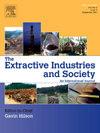南部非洲稀土矿物的可持续开发:探讨其联系
IF 4.3
2区 社会学
Q2 ENVIRONMENTAL STUDIES
Extractive Industries and Society-An International Journal
Pub Date : 2025-08-19
DOI:10.1016/j.exis.2025.101754
引用次数: 0
摘要
本文通过对南部非洲稀土矿产价值链的关注,解决了矿产部门的可持续性问题。分析中采用的方法规定将比较优势的各个方面纳入实现可持续发展目标,因为位于特定管辖区的稀土矿物禀赋可以有助于实现这些发展里程碑。该分析采用了稀土矿产储量、南部非洲发展走廊、矿产工业和相关基础设施、可持续发展基础设施质量指数、太阳能光伏和风能容量以及莫易卜拉欣非洲治理指数等7个数据集。本文中提出的稀土矿物可持续发展途径是通过价值链上至少四个不同的节点。第一个节点是关于稀土矿物勘探和绘制这些矿物的前景以及有关的社会经济发展问题。它确立了发展走廊的作用,通过整合矿藏丰富地区的节点,促进勘探,并为整个区域运输投入和产出提供途径。第二个节点根据可持续开采稀土矿物的能源需求评估该区域的能源能力。该节点还评估了矿山的位置和采用的开采技术,以确保通过解决废弃矿山的挑战来减少对自然栖息地的碳排放足迹。第三个节点侧重于分析稀土矿物加工中心的位置及其与运输和发展走廊的关系。这促进了利益从当地矿区扩展到其他地区,并确保这些走廊成为矿物加工中心选址的拉动因素。第四个节点是横切,建立稀土矿产的安全和地缘政治格局。本文的结论是,可持续性应该通过实现特定目标和沿着每个不同商品价值链实现目标的路径的直接和间接影响来衡量。这确保了矿产部门的可持续发展道路具有较低的碳足迹,促进包容性和可持续增长,重新定位南部非洲在稀土矿产区域和全球价值链中的地位,并通过利用发展走廊,通过提高附加值、提高加工能力和建立综合运输网络来应对社会经济挑战。本文章由计算机程序翻译,如有差异,请以英文原文为准。
Sustainable exploitation of rare earth minerals in Southern Africa: Exploring the linkages
This paper addresses sustainability issues in the minerals sector through a focus on the rare earth minerals value chain in Southern Africa. The approach employed in the analysis provides for the incorporation of aspects of comparative advantage in the attainment of the sustainable development goals, as rare earth mineral endowments located in specific jurisdictions can contribute to the accomplishment of these development milestones. The analysis employed seven datasets on rare earth mineral occurrences, development corridors in Southern Africa, Mineral Industries and Related Infrastructure, the quality infrastructure for sustainable development index, Solar PV and wind energy capacity and data on the Mo Ibrahim index of Africa governance. The rare earth minerals pathway to sustainability argued in this paper is through at least four distinct nodes along the value chain. The first node is on rare earth minerals exploration and maps prospectivity of these minerals and the associated socio-economic development issues. It establishes the role of development corridors in facilitating exploration through the integration of nodes of deposit-rich areas and providing a pathway in the transportation of inputs and outputs across the region. The second node assesses the region’s energy capacity against the energy requirements for the sustainable extraction of rare earth minerals. This node also assesses the location of the mines and the extraction technologies employed to ensure a reduction in the carbon emission footprint on the natural habitats through addressing the challenges of abandoned mines. The third node focuses on analysis of the location of rare earth mineral processing centers and their relationship with transport and development corridors. This fosters the spread of benefits beyond the local mining areas to other regions and ensures that these corridors act pull factors for the location of mineral processing centers. The fourth node is crosscutting and establishes the security and geopolitical landscape of rare earth minerals. The paper concludes that sustainability should be measured by both the attainment specific goals and the direct and indirect impacts along the pathway towards the attainment of the goals along each distinct commodity value chain. This ensures that the path to sustainable development in the minerals sector has a lower carbon footprint, fosters inclusive and sustained growth that reorients Southern Africa’s position in the rare earth minerals regional and global value chains and addresses socioeconomic challenges through enhanced value addition, growing processing capacity and an integrated transport network through leveraging development corridors.
求助全文
通过发布文献求助,成功后即可免费获取论文全文。
去求助
来源期刊

Extractive Industries and Society-An International Journal
ENVIRONMENTAL STUDIES-
CiteScore
6.60
自引率
19.40%
发文量
135
 求助内容:
求助内容: 应助结果提醒方式:
应助结果提醒方式:


